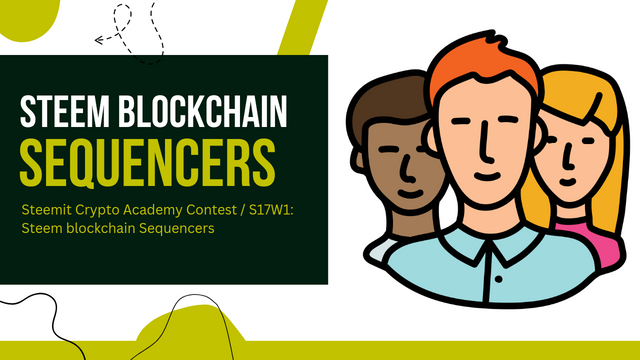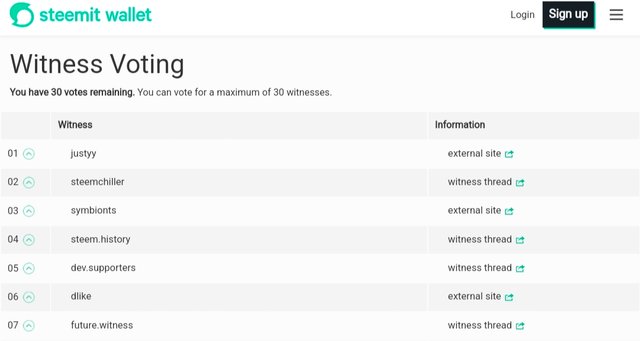Steemit Crypto Academy Contest / S17W1: Steem blockchain Sequencers

Hello everyone! I hope you are all doing well and enjoying life with the blessings of Allah Almighty. I am happy to take part in the exciting challenge hosted by SteemitCryptoAcademy community . So, without any further delay, let's dive right in! Shall we ? ........, Okay , Okay😊! .
What are the main building blocks of a blockchain and how does the process of sequencing transactions work in a blockchain network? |
|---|
Blockchains are transparent, secure data storage systems similar to digital ledgers. Envision a public notebook in which entries are visible to everybody, but where entries cannot be altered.
This is made feasible by the unique technologies that blockchains employ, such as decentralization—the dispersion of information over numerous computers as opposed to its central location—and cryptography, which functions similarly to secret codes.
Let's now discuss the social networking site Steemit, which makes use of blockchain technology. People can produce, share, and receive rewards for high-quality material on Steemit. A device known as a sequencer, which functions as the Steem blockchain's equivalent of the traffic cop, makes this feasible.
It makes sure that transactions, like posting a new article or liking a post, happen in the right order and are verified by the community.
It's critical to comprehend how this sequencer operates because it maintains security and fairness throughout Steemit. The sequencer makes sure that transactions occur in the correct order and that no one circumvents the system by cutting in front of others or waiting their turn, much like we do while we're in line at the grocery store.
We can gain a better understanding of how blockchain technology functions in practice by studying about the sequencer and how it affects websites like Steemit.
Gaining an understanding of the fundamentals allows you to explore more complex concepts and observe how they are affecting the world around us, much like when you unlock a new level in a video game.
Describe how the Steem blockchain sequencer works, highlighting its specific characteristics and its role in consensus. Illustrate a graphical diagram to explain how it works. |
|---|
There are unique users on the Steem blockchain known as Witnesses, and they serve as the sequencer. Consider them as Steemit's traffic controllers.
When someone posts anything or engages with information, Witnesses ensure that everything happens in the correct sequence. They oversee transparency and fairness on the site, much like the referees.

Canvas source Consensus on Steemit is heavily influenced by witnesses. To be in consensus is to have everyone agree on what is just and fair. Witnesses are thereby assisting the community in reaching a consensus when they arrange and verify transactions.
It resembles a deliberative process in which all participants have a voice.
 |
|---|
Certain features of the Steem blockchain sequencer provide it reliability. For instance, it is decentralized, which means that power is shared among Witnesses rather than in the hands of one individual.
This makes sure that nobody can take advantage of the system to their own advantage. Visualizing the sequencer's operation can be aided by providing examples.
You may depict Witnesses validating and sorting transactions on a diagram. It is simpler to comprehend how Steem's sequencer works and how important it is to preserving consensus and fairness thanks to this graphic representation.

What are the different consensus algorithms used in blockchains, and how do they influence the transaction sequencing process? |
|---|
It's critical to comprehend how blockchains reach consensus over which transactions are okay. Transaction sequencing is influenced by several consensus algorithms that are involved in this process.
1. Proof of Work (PoW):
PoW pits miners against one another in a race to figure out challenging math problems. A new block of transactions is added to the blockchain by the first person to solve it. This affects transaction sequencing since the order of transactions in the block is determined by the order in which miners solve the problem. Nevertheless, PoW is slower and less effective because it needs a lot of time and energy.
2. Proof of Stake (PoS):
Validators in Proof of Stake (PoS) are selected according to the quantity of cryptocurrency they own and are prepared to "stake" as collateral. Blocks of transactions are proposed and verified by validators alternately.
This alters the sequencing of transactions because more stakeholder validators are more likely to be selected for validation, which changes the order in which transactions are processed.
PoS uses less energy than PoW, but if a small number of validators possess a large amount of cryptocurrency, it may cause centralization.
3. Delegated Proof of Stake (DPoS):
While DPoS and PoS are similar, DPoS relies on a smaller pool of elected validators to validate transactions. The elected validators alternately propose and validate blocks, which affects the order of transactions.
Although DPoS is quicker and more scalable than PoW and PoS, it may be less decentralized because power is shared by a fewer number of community-selected validators.
Explain the role of different types of nodes (like full nodes, light nodes, etc.) in the process of sequencing transactions within a blockchain. |
|---|
Comprehending the functions of various node types inside a blockchain is essential to comprehending the order in which transactions occur. Every kind of node makes a distinct contribution to this process.
1. Full Nodes:
Consider complete nodes to be the blockchain network's skeleton. They take part in transaction relaying and validation in addition to keeping a complete copy of the blockchain. Because they make sure every transaction complies with the blockchain protocol's guidelines, full nodes are essential to the order in which transactions are completed. Through their independent transaction verification, they contribute to the network's integrity and security.
2. Light Nodes:
The complete blockchain is not stored by light nodes, sometimes referred to as lightweight nodes or SPV (Simplified Payment Verification) nodes. Rather, they depend on entire nodes to verify transactions and simply keep block headers. Light nodes help sequence transactions by rapidly retrieving and validating transaction data from full nodes, even though they use less bandwidth and storage than full nodes. In applications and mobile wallets with constrained resources, light nodes are frequently employed.
3. Mining Nodes:
Mining nodes are specialized nodes that take part in the mining process, which adds new blocks to the blockchain. When a miner solves a challenging mathematical puzzle with the aid of powerful computers, a new block of transactions is generated. Because they compete to be the first to add their proposed block to the blockchain, mining nodes have an impact on transaction sequencing. Through Proof of Work or other consensus techniques, this competitive process guarantees the order of transactions and upholds the network's security.
4. Validator Nodes:
Validator nodes are in charge of verifying blocks and transactions in blockchain networks that employ consensus procedures such as Proof of Stake. By endorsing new blocks to be added to the blockchain and validating transactions, validators are essential to the sequencing of transactions. Validator nodes correctly validate and sequence transactions, which contributes to consensus maintenance and the seamless operation of the blockchain network.
Discuss the importance of decentralization and governance in the context of the Steem blockchain. How does Steem's governance structure affect transaction sequencing and network security? |
|---|
In Steem, decentralization and governance are crucial. Decentralization is the dispersal of power rather than its concentration in one person. The judgments and regulations set by the community are comparable to governance. Because everyone has a voice on Steem, decisions are made fairly and openly.
The order of transactions is determined by the Steem governance system. It resembles a team choosing who gets to go first in a match. Fairness is guaranteed by this arrangement, which also keeps one individual from having total control.
Furthermore, because choices are made collaboratively rather than by a single authority, it increases network security.
In a decentralized system like Steem, no single entity or person holds absolute control. Rather, choices are decided upon by the community, enhancing the platform's democratic nature. In this way, everyone's opinion counts and nobody can take advantage of the system.
In Steem, governance is similar to game rules. It controls the process of adding and validating transactions to the blockchain. This keeps the community's peace and trust intact. It also guarantees the network's safe and efficient operation.
Let's say you want to share a great essay you created on Steemit. You start by writing your post and uploading it to the website. It's analogous to placing a letter in a mailbox. The sequencer on the Steem blockchain then starts operating. It verifies that your post complies with all regulations, aligns it with other ongoing transactions, then checks it again.
Fairness and openness are guaranteed by this procedure. The community then gets together to validate your post via its governance system. It resembles a bunch of buddies endorsing your piece.
It looks a bunch of buddies supporting your piece. Following validation, your post is added to the blockchain, and you may receive compensation for your efforts. This real-world illustration demonstrates how governance, community validation, and transaction sequencing are all put to use in the running of Steem.
With Best Regards
@artist1111

Goodbye, friends. It's been a pleasure getting to know you all participating in this community. I will miss interacting with all of you, but it is time for me to move on. Take care & I hope to see you all again very soon , Best of Luck .
As the sun sets on the day
And the night falls softly in
We close this chapter, dear reader
But the story's not yet done
Tomorrow's pages wait, unwritten
INTRODUCTION
As the sun sets on the day
And the night falls softly in
We close this chapter, dear reader
But the story's not yet done
Tomorrow's pages wait, unwritten
INTRODUCTION
Upvoted. Thank You for sending some of your rewards to @null. It will make Steem stronger.
Saludos cordiales estimado amigo artist1111, un gusto saludarte, leer y dejarte este comentario.
Los secuenciadores steem están representados por nuestros testigos, ellos trabajan día a dia para mantener el sistema funcional, de ellos depende la continuidad de nuestra cadena de bloques, muy buena participación amigo.
Te deseo éxito y muchas bendiciones.
Thanks for recognizing the importance of Steem witnesses in maintaining our blockchain. Your participation is commendable. Wishing you success and blessings!
@artist1111 your insightful breakdown of blockchain technology especially with a focus on Steem and its sequencer. Your explanations are crystal clear making complex concepts easy to grasp. I genuinely appreciate the effort you've put into this post. Best of luck
Thanks for acknowledging the clarity of my explanations. Your encouragement means a lot. Best wishes to you too!
Understanding blockchain is like grasping the concept of a digital ledger where every entry is visible yet secure. It's akin to keeping track of expenses in a family budget spreadsheet, ensuring transparency and accountability.
It's like when my friends and I organize a game night. We take turns picking games and making sure everyone gets a chance to play. Similarly, on Steemit, the sequencer ensures fairness by organizing transactions, much like a traffic cop keeps order on the road.
It's similar to when my family decides where to go for dinner. We discuss options until everyone agrees on a choice. Likewise, in blockchain, consensus algorithms ensure everyone agrees on valid transactions, maintaining order and security in the network.
All the best
Thanks for the insightful analogies! Understanding blockchain consensus feels clearer now. Best wishes to you too! 🚀
Your article uses a succinct description of blockchain modern technology likening it to a clear electronic journal where access stay unalterable. The conversation on Steemit's use blockchain includes an useful instance highlighting exactly how the modern technology allows decentralized social networking and also incentivizes top quality material production. The example of the sequencer as a web traffic police officer guarantees reasonable and also organized deals mirroring real-world situations like waiting in line. Comprehending these fundamental principles is without a doubt vital for diving right into the more comprehensive applications of blockchain modern technology a lot like open brand-new degrees in a computer game discloses much deeper intricacies.
Greetings friend,
Your article simplifies blockchain technology by comparing it to a clear digital journal. It shows how Steemit uses blockchain for decentralized social networking and rewards quality content creation. The sequencer example ensures fair and organized transactions, like waiting in line. Understanding these basics is crucial for exploring broader applications of blockchain technology. Good luck
Thanks for the insightful your time .Understanding blockchain basics is indeed crucial for exploring its broader applications. Cheers to that! 🎮
My pleasure friend.
Hello friend greetings to you, hope you are doing well and good there.
You have beautifully explained the Blockchain technology. You have said that, blockchains are transparent, secure data storage systems similar to digital ledgers. Yes this is very much true. Blockchain keeps all our transaction Data.
You have beautifully explained different kind consensus algorithms.Proof of Work (PoW), Proof of Stake (PoS), Delegated Proof of Stake (DPoS) are these different types of algorithm.
All the types of nodes are very briefly explained too. You have presented a too much beautiful example of explaining the transaction process. Your post is amazing. It's really nice to read it out here.
I wish you very best of luck in this contest.
Thanks for your kind words! Glad you found the explanation helpful. Best of luck to you too! 🌟
Yes friend is necessary to consider the fairness and openness on a blockchain this helps us way how decentralized the platform is and how easily users get to use this platform without any threat or position.
Thanks for sharing such quality article, wishing you the best please keep it up. Kindly drop a comment to my post using the link https://steemit.com/hive-108451/@starrchris/sec-s17-w1-or-or-steem-blockchain-sequencers
Thanks for highlighting fairness and openness. Your analogy of friends endorsing a piece is spot on. Best wishes to you too! 🌟